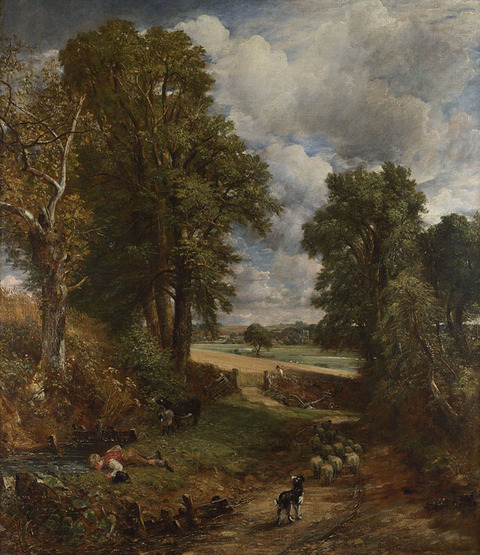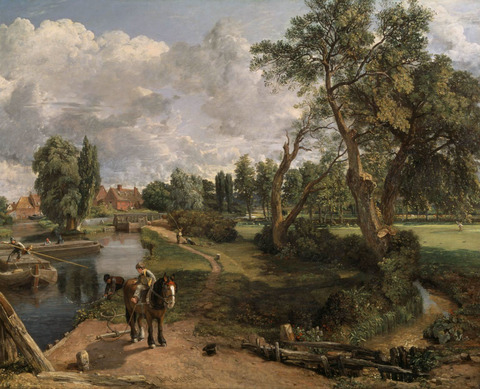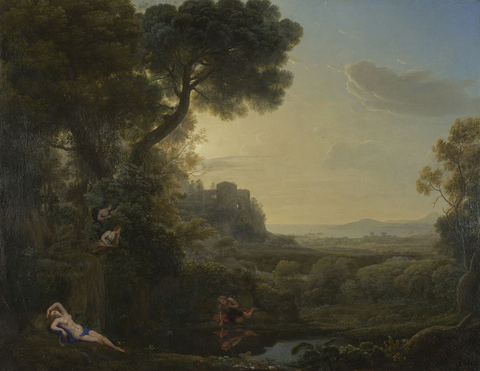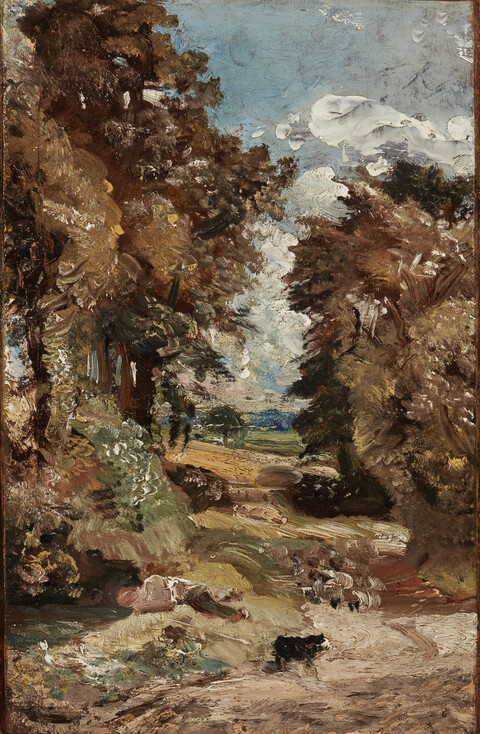Marks, Inscriptions, and Distinguishing Features
None
Entry



8I have dispatched a large landscape to the Academy—upright the size of my lock—but a subject of a very different nature—inland—cornfields—a close lane—kind of thing—but it is not neglected in any part the trees are more than usually studied and the extremities well defined—as well as their species [?stems]—they are shaken by a pleasant and healthful breeze—"at Noon”—“while now a fresher gale, sweeping with shadowy gust the feilds [sic] of corn” &c &c…. I am much worn, having worked very hard—& have now the consolation of knowing I must work a great deal harder. Or go to the workhouse. I have however work to do—& I do hope to sell this present picture—as it has certainly got a little more eye-salve than I usually condesend [sic] to give to them.17
Author
Provenance
Sold in the artist's estate sale at (Foster and Sons, London) in 1838;
Radford.21
Probably (Thomas Agnew, London);22
Charles T. Eames, Boston, about 1885;
By descent to G.L Eames, Boston.23
Via (Ivan N. Podgoursky, Boston), to G.H.A. Clowes, Indianapolis, in 1937;24
The Clowes Fund, Indianapolis, from 1958–2009 and on long-term loan to the Indianapolis Museum of Art since 1971 (C10024);
Given to the Indianapolis Museum of Art, now the Indianapolis Museum of Art at Newfields, in 2009.
NB: This documentation of the provenance cannot be reconciled with an alphanumeric code of stenciled letters on the right stretcher member: 305GG; see Technical Examination Report. This code can be linked to a consignment of 62 paintings brought to Christie’s, London, in April 1936 by “Mrs. H. Shirlaw” of Putney. Christie’s “Daybooks” record that items from the Shirlaw consignment went to auction on 27 May 1936, although this painting presumably went back to the owner before the sale; for correspondence with Christie’s Archives in August 2018, see IMA Provenance File C10024.
Exhibitions
John Herron Art Museum, Indianapolis, 1941, Early British Masters, no. 3;
John Herron Art Museum, Indianapolis, 1959, Paintings from the Collection of George Henry Alexander Clowes: A Memorial Exhibition, no. 15;
Indiana University Art Museum, Bloomington, 1963, Northern European Painting: The Clowes Fund Collection, no. 55;
Salander-O’Reilly Galleries, Inc., New York, 1988, John Constable, R.A. (1776–1837): An Exhibition; Paintings, Drawings, Watercolors, Mezzotints, no. 25;
Tate Gallery, London, 1991, John Constable, no. 164.
References
A. Ian Fraser, A Catalogue of the Clowes Collection (Indianapolis: Indianapolis Museum of Art, 1973), 98;
Robert Hoozee, L’opera completa di Constable (Milan: Rizzoli Editore, 1979), 152, no. 692, dated 1826 (rejected attribution);
Graham Reynolds, Charles Rhyne, and Julius Meier-Graefe, John Constable, R.A. (1776–1837): An Exhibition; Paintings, Drawings, Watercolors, Mezzotints, exh. cat. (New York: Salander-O’Reilly Galleries, Inc., 1988), 18–19, no. 25;
Michael Brenson, “2 Sides of Constable: Classic and Romantic,” The New York Times, 13 May 1988;
Hilton Kramer, “Fine Show of Constable, Patron Saint of the Impressionists,” The New York Observer, 6 June 1988;
Leslie Parris and Ian Fleming-Williams, Constable, exh. cat. (London: Tate Gallery, 1991), 300,no. 164;
Graham Reynolds, The Times Literary Supplement, 21 June 1991;
Graham Reynolds, The Early Paintings and Drawings of John Constable (New Haven and London: Yale University Press, 1996), 232, no. 16.100, pl. 1360;
Judy Egerton, National Gallery Catalogues: The British School (London: National Gallery Press, 1998);
Ian St. John, East Bergholt: Constable Country (East Bergholt, Suffolk: Suffolk Walker, 2002), 31, fig. 42 (dated 1826);
Pierre Wat, Constable (Paris: Editions Hazan, 2002), 44–45, fig. 28.
Technical Notes and Condition
The canvas is supported by an old lining. Tacking holes are visible on the lower left and right sides of the painting, and a crease suggests that the original tacking margins were overpainted and incorporated into the composition. There are no observable pentimenti under IRR. The oil paint was applied using a wet-in-wet technique with pigments blended directly on the canvas in places. A medium-sized, hard-bristled brush was used in addition to a hard-edged tool, such as a palette knife. Although some areas of the composition are painted more thinly, in areas where impasto is present, it is well preserved.
Notes
-
Graham Reynolds, Charles Rhyne, and Julius Meier-Graefe, John Constable, R.A. (1776–1837): An Exhibition; Paintings, Drawings, Watercolors, Mezzotints, exh. cat. (New York: Salander-O’Reilly Galleries, 1988), no. 25. ↩︎
-
Michael Brenson, “2 Sides of Constable: Classic and Romantic,” The New York Times, 13 May 1988. ↩︎
-
Hilton Kramer, “Fine Show of Constable, Patron Saint of the Impressionist,” The New York Observer, 6 June 1988. ↩︎
-
As Fuseli purportedly remarked to the artist Augustus Callcott upon seeing Constable’s Salisbury Cathedral from the Meadows. See C.R. Lesie, R.A., Memoirs of the Life of John Constable Composed Chiefly of His Letters (London: Phaidon Press, 1951), 101. ↩︎
-
As found in “Constable and the Present,” Modern Art: The Struggle for Painting, vol. 1, 1906, reprinted in John Constable, R.A. (1776–1837): An Exhibition; Paintings, Drawings, Watercolors, Mezzotints, exh. cat. (New York: Salander-O’Reilly Galleries, 1988), 88. ↩︎
-
Graham Reynolds, verbal communication with Mark Roskill, 1966. Reynolds’s opinion was supported by Roskill in his unpublished “Clowes Collection Catalogue” from 1968. Reynolds suggested an alternative attribution to William White Warren (1832–1911/1912), dated about 1900. ↩︎
-
Robert Hoozee, L’opera completa di Constable (Milan: Rizzoli Editore, 1979), 152. ↩︎
-
On 20 January 1988, Rhyne wrote to George Clowes’s son Allen: “Having compared the slides I took of your oil sketch, The Cornfield, with slides of other related works, I am convinced that the doubts that have been expressed about its attribution to Constable are ill founded and that it is the sketch from nature by Constable, which Constable scholars have assumed was missing.” Letter from Charles S. Rhyne to Allen W. Clowes, 20 January 1988, File C10024, Clowes Registration Archive, Indianapolis Museum of Art at Newfields. Rhyne’s reassessment of the sketch led him to request it for inclusion in the planned exhibition of Constable’s work at the Salander-O’Reilly Gallery in 1988. ↩︎
-
Charles Rhyne, “Discoveries in the Exhibition,” in Graham Reynolds, Charles Rhyne, and Julius Meier-Graefe, John Constable, R.A. (1776–1837): An Exhibition; Paintings, Drawings, Watercolors, Mezzotints, exh. cat. (New York: Salander-O’Reilly Galleries, 1988), 18. The National Gallery painting originally was titled The Drinking Boy by Constable in 1826, only later acquiring the name that it is known by today. ↩︎
-
Hickman Bacon Collection, UK, measuring 23-1/2 × 19-3/8 in. A copy of the image was unobtainable at time of publication. ↩︎
-
Leslie Parris and Ian Fleming-Williams, Constable, exh. cat. (London: Tate Gallery, 1991), 300. ↩︎
-
Graham Reynolds, The Early Paintings and Drawings of John Constable (New Haven and London: Yale University Press, 1996), 232. Reynolds had the opportunity to examine the painting firsthand with the museum’s senior paintings conservator David Miller shortly before the 1988 exhibition. ↩︎
-
Constable to the Rev. John Fisher, 23 October 1821; quoted in R.B. Beckett, ed., John Constable’s Correspondence, vol. 6: The Fishers (London: Suffolk Records Society, 1968), 76–78. ↩︎
-
Letter from Charles Golding to the Art Journal, 1869, 118. ↩︎
-
Alastair Smart and Attfield Brooks, Constable and His Country (London, 1976), 107–119. ↩︎
-
Michael Rosenthal, Constable: The Painter and His Landscape (New Haven and London: Yale University Press, 1983). ↩︎
-
Constable to the Rev. John Fisher, 8 April 1826; quoted in R.B. Beckett, ed., John Constable’s Correspondence, vol. 6: The Fishers (London: Suffolk Records Society, 1968), 216–17. ↩︎
-
Robert Hunt in The Examiner, London, 2 July 1826. ↩︎
-
According to Bank of England inflation calculator. See https://www.bankofengland.co.uk/monetary-policy/inflation/inflation-calculator. ↩︎
-
Constable to the Rev. John Fisher, October 1821; quoted in R.B. Beckett, ed., John Constable’s Correspondence, vol. 6: The Fishers (London: Suffolk Records Society, 1968), 76–78. ↩︎
-
Foster and Sons, London, A Catalogue of the Valuable Finished Works, Studies, and Sketches of John Constable, Esq., R.A. Deceased, 16 May 1838, part of lot 14 (“The Cornfield; a study from nature, for the picture in the National Gallery”). An annotated copy of this auction catalogue lists “Radford” as the purchaser. ↩︎
-
Foster and Sons, London, A Catalogue of the Valuable Finished Works, Studies, and Sketches of John Constable, Esq., R.A. Deceased, 16 May 1838, part of lot 14 (“The Cornfield; a study from nature, for the picture in the National Gallery”). An annotated copy of this auction catalogue lists “Radford” as the purchaser. ↩︎
-
Letter from G.L. Eames to Ivan Podgoursky, 24 September 1937, File 2009.53 (C10024), Clowes Registration Archive, Indianapolis Museum of Art at Newfields. ↩︎
-
Letter from G.L. Eames to Ivan Podgoursky, 24 September 1937, File 2009.53 (C10024), Clowes Registration Archive, Indianapolis Museum of Art at Newfields. ↩︎
